 Written by Brittany Ferri, OTR/L
Written by Brittany Ferri, OTR/L
A transfer device, also referred to as patient transfer equipment or a transfer aid, is a mobility aid to more easily move people with mobility challenges to and from a wheelchair, chair, bed, car, bathtub, or toilet safely. According to the CDC, falls are the leading cause of death for people over 65, and transfer devices - also called patient transfer equipment or a patient transfer aid - lower the risk of patient falls and caregiver strains and injuries.
Self-transfer mobility aids are made for people who only need a bit of assistance when transitioning between sitting and standing. These transfer aids usually require some arm strength, but often don’t require any caregiver assistance to use safely. Examples of self-transfer devices include a swivel seat cushion, vehicle assistance straps, and car door automotive handle standing aids.
Assisted transfer devices are best for individuals who need some caregiver assistance. These devices work with the effort of the patient and the caregiver, but don’t require the same level of patient strength that self-transfer aids do. Transfer belts and transfer boards are examples of devices designed for assisted transfers.
For patients whose mobility is severely impaired and who rely on caregivers for any transfers, aids that allow for multiple caregivers to handle them are most appropriate. These include transfer blankets and slings that a team of caregivers uses at once to ensure a safe transfer of an immobile patient.
Patient lifts are used to move patients who have little or no independent mobility. They are designed to take the physical strain of patient transfers off caregivers and provide a safe and comfortable patient experience. They are also known as handicap lifts, people lifts, mechanical lifts, and hospital lifts.
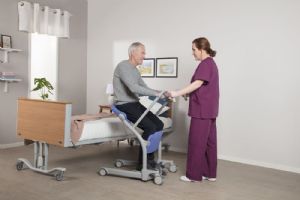 | Sara Stedy Patient Transfer Aid by ArjoHuntleigh (FULLY ASSEMBLED) View Product |
To decrease the risk of a fall, promote regular position changes, and help patients reach a natural standing posture, a sit-to-stand lift secures a patient during transfers. Patients can quickly, easily, and safely be moved from a seated to a standing position, taking the strain off the user and the caregiver. These lifts require the use of a sling, and with many models of lifts and slings to choose from, you are encouraged to read How to Choose the Best Patient Lift Sling to help you make an informed buying decision.
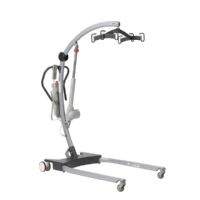 | LEVANTAR Heavy-Duty Floor Patient Lift by Drive Medical View Product |
A floor lift is a powered patient lift often used to assist a person who has fallen to get back on their feet. Floor lifts are mobile and can be moved from room to room or even taken along on vacation to assist with patient transfers. Powered patient lifts are also commonly called people lifts, handicap lifts, and hospital lifts, and they decrease the risk of caregiver strain and injury. Most floor lifts require a sling, which wraps around the back of the patient and attaches to the lift.
 | Handicare Ceiling Mounted Lift C-450 Manual Traverse Lift View Product |
Offering a wide range of options and movement, ceiling lifts help a caregiver raise, lower, tilt, and roll a patient. A ceiling lift is either mounted on a rail system that is permanently installed or it’s a freestanding lift that hydraulically lifts and transfers patients in a sling seat. These patient transfer devices require a sling and are popular because their overhead design decreases floor clutter and frees up space in smaller rooms. Weight capacity is a significant factor when choosing the most appropriate ceiling lift. Ceiling lifts by Handicare come in various options, making purchasing an all-inclusive lift and track package easy.
A bed transfer aid helps move an individual from one side of the bed to the other, assists in sitting a user up, or moving them to and from a bed to a chair or wheelchair. This type of mobility aid significantly reduces the risk of injury to a patient or caregiver while changing a patient’s position or getting them in and out of bed.
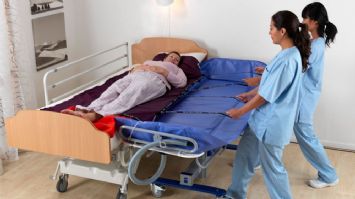 | Low Friction Patient Transfer Sheets with Handles - MaxiSlides from Arjo View Product |
A transfer sheet, also called a slide sheet or a glide sheet, reduces friction on the skin when a patient is being repositioned. These patient transfer products can be used alone or with any other patient transfer equipment to help transfer, turn, and boost someone in bed.
 | Length Adjustable Bed Assist Rail from Stander View Product |
Bed rails are popular transfer aids because they can reduce the need for caregiver assistance. They securely attach to the bed frame or mattress and provide a sturdy place for patients to grab on and pull themselves out of bed or help transfer them into bed. These transfer aids are also known as bed safety rails and bed assist rails. Users who have upper body strength can maintain a higher level of independence by using a bed rail for balance and leverage to get themselves in and out of bed. To help you choose the best bed rail for your situation, read about our Top 5 Bed Rails for Traditional Home Beds.
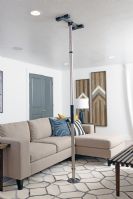 | Security Pole with Curved Grab Bar and Attachments View Product |
Poles, grab bars, and assist handles are portable, removable devices either attached to or positioned near a user’s bed or in the bathroom. Each of these transfer devices reduces the risk of falling, assist in repositioning while in bed, and aid in getting in and out of bed.
Bed assist poles are height-adjustable vertical posts that are securely attached to the floor and the ceiling. They can be used in a bathroom near a tub or toilet for extra stability, and they take up very little space. Accessories for these devices include grab bars or rails and trapeze handles.
Grab bars, also called wall bars, are safety transfer devices that enable a person to maintain balance, decrease fatigue while standing, redistribute weight, and grab in case they start to slip or fall.
Assist handles are similar to bed safety rails. The difference is they are often smaller and meant to be used with one hand. They can be mounted to the bed or on the floor with non-skid feet. They are best for users who can stand on their own with minimal assistance.
 | Mobility Assistance Ladder - Bed Caddie from Stander View Product |
A bed ladder, sometimes called an assistive strap or bed ladder strap, allows a patient who has enough arm strength to sit up independently. By grabbing the handholds on the band of webbing, the patient can pull up to a sitting position in bed without relying on assistance from a caregiver.
About 80 percent of the falls that occur with people over the age of 65 happen in the bathroom. Utilizing bathroom transfer aids significantly decreases the potential risk of a dangerous fall while toileting or bathing.
 | Knurled Steel Grab Bars for Bathroom Safety - Chrome Plated, Textured Grip, Rust Resistant View Product |
Bathroom grab bars, also called bathroom grab rails, offer support and accessibility in navigating the use of toilets, showers, and bathtubs, especially in a wet and slippery environment. There are many designs and configurations to fit in potentially small spaces, providing supportive handholds wherever they’re needed to help a user maneuver around the bathroom.
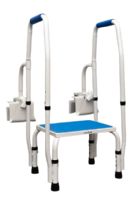 | Step 2 Tub Bathtub Safety Step with Rail View Product |
A bathtub or shower grab bar helps a user maintain their balance while standing, moving around, or getting in and out of a tub or shower. Having a stable handhold, especially in a wet tub or shower, helps prevent slip and fall accidents. Check out our picks for the Top 5 Best Bathtub Rails, and get more information on the features and benefits of this type of transfer device.
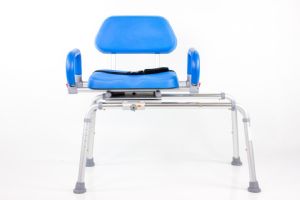 | Sliding Transfer Shower Bench with Swivel Chair by Platinum Health View Product |
For people who can’t lift their legs while staying balanced or if standing in a wet tub or shower is dangerous due to strength and balance challenges, a bathtub shower bench can make bathing safer and more enjoyable. To explore the features available with these patient transfer devices, read about our list of 5 Best Bathtub Transfer Benches and how they transfer users into a safe, seated, and enjoyable bathing experience.
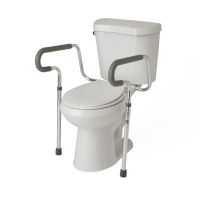 | Guardian Toilet Safety Frame by Medline View Product |
A toilet safety frame delivers stability and confidence for anyone who can’t safely raise and lower themselves from a toilet. This transfer device makes toileting easier and allows for privacy and independence in the bathroom. Typical designs include free-standing, toilet-attached, and wall-mounted options.
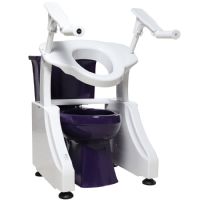 | Deluxe Toilet Lift by Dignity Lifts View Product |
Those with mobility issues, joint problems, or lack of strength in their hips and legs can benefit from a toilet lift. These lift seats are power-operated and can be used without a caregiver’s assistance, promoting privacy and independence. A toilet lift takes the weight off the user’s joints, reducing the risk of a fall for people who struggle to maintain balance while standing up from or lowering onto the toilet.
Lifting and moving someone into and out of a wheelchair or chair is one of the most strenuous activities required of a caregiver. These patient transfer devices are compact, easy to use, and significantly decrease the physical strain of caregiving.
 | Posey Nylon Patient Transfer Belts View Product |
For someone who is not strong or steady enough to walk independently, a transfer belt is a simple piece of patient transfer equipment a caregiver can use to assist with standing and walking short distances. Also called a gait belt, a transfer belt is put around a patient’s waist while the caregiver holds the end or a handle for assistance and support when moving between a bed, chair, wheelchair, or car.
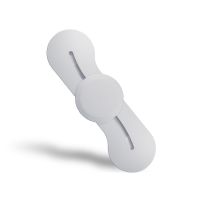 | BeasyTrans Original Transfer Board With Rotating Seat View Product |
Also called sliding boards or smooth movers, transfer boards help individuals with limited upper body strength to move from one place to another while lowering the risk of falls and reducing the risk of leg or back injuries for caregivers. While sitting on the board, the patient’s upper body is supported by the caregiver, who slides the patient from one seat to another, without any lifting.
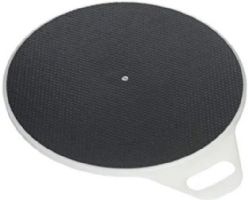 | SafetySure Transfer Pivot Disc View Product |
For a wheelchair user who has good weight-bearing ability but can’t move their feet to turn or change positions, using a pivot disc facilitates safe transfers. A pivot disc, also called a pivot aid or a turntable, is positioned flat on the floor in front of the patient and very near the destination chair, wheelchair, or bed. The patient rises to stand on the disc, a caregiver turns the patient via the pivoting disc, and the patient lowers onto the bed, chair, or wheelchair.
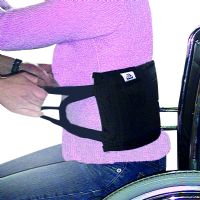 | SafetySure Transfer Sling with 4 Handles View Product |
A transfer sling is a sit-to-stand transfer aid that is usually snugly positioned under a patient’s bottom and/or around the midsection to provide caregivers with a handhold to help pull the patient up and provide stability once the patient is standing. These transfer devices help caregivers maintain their grip during transfers.
A car trip is a daily life activity that can present significant challenges for people with limited mobility. Getting in and out of the car can be tiring - and risky - for someone with diminished strength and balance. Transfer aids that make these transfers safer and easier contribute to a user’s quality of life.
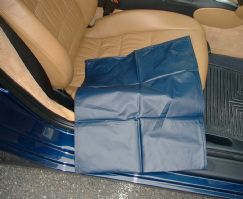 | Car Transfer Slide Sheet for Entry and Exit - SafetySure CarEase View Product |
One thing that inhibits smooth car transfers is the inability to easily slide across a seat when getting in and out of a car. A transfer slide sheet conveniently folds up in the glove compartment when not in use. Unfolded and placed across the seat under the user, it provides a frictionless surface for sliding into a comfortable and safe position on the car seat.
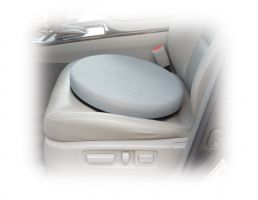 | Drive Medical Padded Swivel Seat Cushion View Product |
Placed on the car seat, a swivel car seat cushion allows a user to rotate positions while seated. While seated on the cushion, the user can pivot while facing forward, eliminating the need to twist or lean while getting into and out of a car.
 | CarCaddie Vehicle Assistance Strap View Product |
A vehicle assistance strap is an easy-to-install-and-use piece of transfer equipment that makes car travel safer for people who need some extra stability while getting in and out of a car. A vehicle assistance strap goes around the window frame, installs in seconds, and provides a handhold for balance while transferring to and from a vehicle.
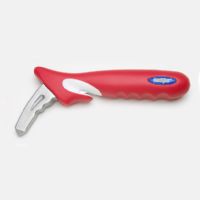 | HandyBar Support for Vehicle Entry and Exit View Product |
A car door automotive handle standing aid is a convenient, portable device that fits into the striker plate of the door when the car door is open and provides a stable handle to grip for leverage while getting in and out of a car. It’s known by many names, including car door handle aid, car grab handle, car door assist handle, and car door handle assist bar, and can typically support a user weighing up to 350 pounds.
 | BeasyTrans Original Transfer Board With Rotating Seat View Product |
A transfer board is our top choice for an assisted or independent transfer from the bed to a wheelchair. It doesn’t require as much upper body strength as other transfer aids and it allows a user to move between surfaces without having to use their legs. It also uses several small movements rather than requiring the energy to make one big motion.
 | Etac Transfer SupportBelt with Handles View Product |
To move from a wheelchair to a chair, we recommend a transfer belt with handles. These mobility aids for assisted transfers provide firm handholds for caregivers to grip and help a patient safely stand up from a wheelchair and move to a nearby chair.
 | Sit-to-Stand Couch and Chair Grab Bar for Mobility Assistance View Product |
Stand-assist handrails serve patients during self-assisted or caregiver-assisted transfers. Lightweight and portable, these transfer devices provide extra leverage through sturdy grip handles when rising from a sitting to a standing position.
Another option is a lift chair, which is a recliner with a motorized mechanism that pushes the chair up from the base to raise and lower the user between standing and sitting. Great for people with arthritis, lower leg neuropathy, joint pain, and balance disorders, these chairs make it easy to simply walk away from the chair after it raises you to a standing position.
A: Standing and raising aids allow patients to be raised for transfer from a bed, wheelchair, chair, or toilet. They encourage users to get up and move to their greatest capability, maintaining as much mobility as possible.
A: Yes, gait belts do help prevent falls. When a person is lacking strength and balance that leaves them at a greater risk for a fall when they are walking or transferring from a sitting to a standing position, a gait belt provides a layer of safety so their balance can be maintained if necessary with the help of a caregiver.
A: Patient transfer equipment is any mobility aid that can help a person with mobility challenges move more easily and safely to and from a chair, bed, wheelchair, toilet, bathtub, or car.
A: A patient lift with a sling is the best choice for patients who are heavier or immobile. Sling lifts transfer patients without putting physical strain on a caregiver, and are easy for caregivers to operate.
A: During a pivot transfer, for a person who has some weight-bearing ability on one or both legs, the user spins on a pivot disc or cushion to change the direction they’re facing and move from one place to another.
A: The two basic kinds of patient lifts are sling lifts and sit-to-stand lifts:
Sling lifts are for patients who are mostly immobile, and sit-to-stand lifts are for people who have some mobility but still need help to go from sitting to standing.
A: With the lift positioned close to the patient, the device’s sling goes around the patient and the lift is engaged. Once the user is standing, the lift is moved out of the way and the patient can walk freely.
A: Since the CDC’s National Institute for Occupational Safety and Health recommends not lifting more than 35 pounds on your own, you should either get another caregiver’s assistance and use a transfer belt or a sling, or you can use a patient lift with a sling to lift them.
A: A floor lift is the best option for lifting someone from the floor safely. The lift’s sling is positioned under the patient then the lift is engaged and the patient is raised without any lifting by the caregiver.
It’s necessary to move, even when mobility is an issue, and patient transfer devices help people safely get to and from a wheelchair, chair, bed, car, tub, or toilet. This equipment reduces the risk of a patient fall, and decreases the physical strain that could cause caregiver injuries.
There are several kinds of patient transfer devices, including patient lifts for moving paralyzed or mostly immobile patients from place to place with minimal strain placed on the caregiver. Patient Lifts are available in a wide variety of models to accommodate patients and caregivers with a range of needs.
Thank you for taking the time to read our guide to patient transfer devices. Please visit Caregiver University for more helpful information on this topic.

Brittany is an occupational therapist who has worked in a variety of rehab facilities. She has always expressed an interest in patients’ internal motivation for therapy and the use of assistive devices, which led her to pursue a PhD in Integrative Mental Health. This research-based training has also led her to develop her writing career to educate patients of all ages on how to improve their health. Brittany has published four books, written over 300 articles, and has been quoted in media outlets such as WebMD, Healthline, and NBC News.